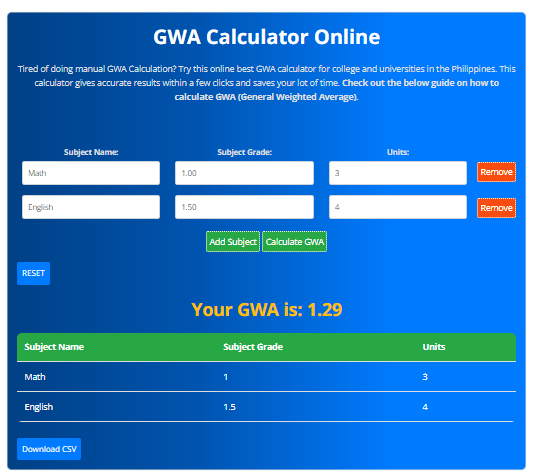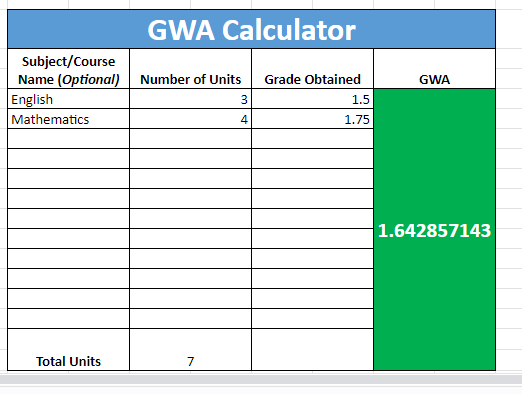GWA Calculator Online Philippines 2024 – Quick & Easy
If you’re looking for how to compute GWA or General Weighted Average for Philippines School, College or Universities, this calculator is specially designed for you.🙂
GWA Calculator Online fast and accurate with a simple and user-friendly interface with the features of adding subject, remove, calculate GWA and download the result in CSV. Furthermore, you will also get a guide on how to calculate your GWA with a manual method and Calculate GWA through Google or Microsoft sheet.
GWA Calculator Online
Tired of doing manual GWA Calculation? Try this online best GWA calculator for college and universities in the Philippines. This calculator gives accurate results within a few clicks and saves your lot of time. Check out the below guide on how to calculate GWA (General Weighted Average).
How to Use GWA Calculator
Following is the procedure of how to compute GWA using a simple and easy to use calculator.
1- Calculate your GWA with this simple and user-friendly GWA calculator within a few clicks.

2 – All you need to enter is your subject name, subject grade and units in the input fields, the rest of the job will be done by this calculator. Easily add your subject through “Add subject” button or you can remove it simply by “Remove” button

3 – Once you fill in all the details, hit the “Calculate GWA” button, you will get your GWA calculated with an accurate and effective formula. Additionally, you can download your result in CSV with all the details you entered.

Grading Point Scale in Philippines Educational Institutes:
| Grade Point Equivalence | Grade Letter Equivalence | Equivalence | GPA Equivalence | Description |
| 1 | A+ | 99–100% | 4.000 | Excellent |
| 1.25 | A | 96–98% | 3.625–3.999 | Very Good |
| 1.5 | A- | 93–95% | 3.250–3.624 | |
| 1.75 | B+ | 90–92% | 2.875–3.249 | Good |
| 2.0 | B | 87–89% | 2.500–2.874 | |
| 2.25 | B- | 84–86% | 2.125–2.499 | Satisfactory |
| 2.5 | C+ | 81–83% | 1.750–2.124 | |
| 2.75 | C | 78–80% | 1.375–1.749 | Pass |
| 3.0 | C- | 75.00–77.74% | 1.000–1.374 | |
| 4.0 | – | – | – | Conditional |
| 5.0 | F | Below 60% | 0.000 | Fail |
| INC | – | – | – | Incomplete |
What is General Weighted Average – GWA
In the Philippines, universities and colleges use the General Weighted Average (GWA) to understand and evaluate how well a student is doing in their studies. It’s an important measure of academic performance.
This easy to use calculator assists students and educational institutes to keep track of the academic progress of the semester or school year.
It figures out the average grade for each subject and its credit hours, telling us how well a student is doing, even if they didn’t pass a subject. It means every subject contributes to the overall calculation of General Weighted Average to help you provide a better view of educational progress.
GWA is like a scorecard for students that helps them to keep track and improve these subjects where they lack to perform well.
How to Compute GWA With Example
In educational institutes of the Philippines, the GWA is calculated by adding the average weightage of each subject of course and the overall credit hours.
To calculate the weight of each subject, multiply the grade you have taken in that subject and multiply it with the corresponding credit hour of that subject
![Rendered by QuickLaTeX.com \[ \boxed{GWA= \frac{\sum_{i=1}^{n}{(g_i * u_i)}}{\sum_{i=1}^{n}u_i}} \]](https://gwacalculatoronline.com/wp-content/ql-cache/quicklatex.com-75635f8df243d113e7c387d093103969_l3.png)
Still confused, I have given an example below that demonstrates the working of GWA.
Suppose you have five subjects: Math, English, Science, History, and Physics.
1- Math:
Grade: A
Credit Hours: 3
Weight for Math = A (1.25) × 3 = 3.75
2- English:
Grade: B
Credit Hours: 4
Weight for English = B (2.0) × 4 = 8.0
3- Science:
Grade: C
Credit Hours: 2
Weight for Science = C (2.75) × 2 = 5.5
History:
Grade: A
Credit Hours: 3
Weight for History = A (1.25) × 2 = 2.5
Physics:
Grade: B
Credit Hours: 1
Weight for Physics= B (2.0) × 3 = 3.0
Now, add up all the weights: 3.75 (Math) + 8.0 (English) + 5.5 (Science) + 2.5 (History) + 3.0 (Physics) = 22.75
Add up all the credit hours: 3 (Math) + 4 (English) + 2 (Science) + 2 (History) + 3 (Physics) = 14
Finally, divide the total weight by the total credit hours to find your GWA:
GWA = Total Weight ÷ Total Credit Hours = 22.75 / 14 = 1.625
So, in this extended example, your General Weighted Average (GWA) considering five subjects is 1.625. It gives you a more comprehensive overview of your academic performance.
How To Calculate A Weighted Average In Excel Or Google Sheet

If you want to calculate GWA using Excel or Google sheet, there is also a Sheet/Excel version.
All you need to enter the required information in order to calculate the GWA.
Here is the link to Google Sheets or Microsoft Excel to calculate the General weighted average.
Benefits of Using an Online GWA Calculator
Calculating grades with GWA comes with several benefits that keep you track the progress of academics accurately and easily.
- Accuracy: Using an online GWA calculator helps you to provide accurate outputs in return of grade and unit with zero chances of error.
- Time-Saving: Manually GWA calculation can be a hectic and time consuming task especially when you are dealing with multiple subjects and credit hours. This online calculator keeps your time saved. All you need to do is enter the subject’s grade and credit hours and you will get a desired output within a few seconds.
- Accessibility: Using online GWA calculators provides convenience of accessibility. It means you can keep track of your academic performance of academics instantly and from anywhere.
- User-Friendly Interface: The calculator interface is simple and easy to use. All you need to enter is the grade and unit to calculate the GWA that gives you the result in seconds.
Tips To Improve Your GWA
- Set Goals: List your specific study goals into smaller achievable tasks that will help you stay concentrated and motivated during your semester or school year.
- Stay organized: keep track of your daily study routine, quizzes and assignment deadlines.
- Participate in class: during class, engage yourself in different discussions, ask questions where you are confused. This will not only improve your knowledge but also boost your confidence.
- Take breaks during study: Alway take a break during study and begin with a fresh mind. According to the Pomodoro Technique by Francesco Cirillo, “it involves studying in short, focused bursts (typically 25 minutes) followed by a short break (5 minutes).” These work intervals also motivate you to concentrate effectively.
- Seek Help When Needed:Don’t hesitate to seek assistance from teachers or classmates when facing challenges.
Conclusion:
In conclusion, the General Weighted Average (GWA) is a crucial measure used in Philippine education to calculate a student’s academic performance. The easy-to-use calculator simplifies the process, allowing students and institutions to monitor progress throughout the semester or school year.
Using this GWA calculator, you can save time without going through a hectic calculation. This calculator uses the exact formula that was used for GWA calculation in Philippines that left no error.
FAQs

Robert Wolf
Robert Wolf, an acclaimed academic and mentor, evolve innovative approaches to education, encourage critical thinking and bring up a love for learning in his students. With a commitment to excellence, he develop an environment where intellectual growth thrives and educational aspirations soar.
